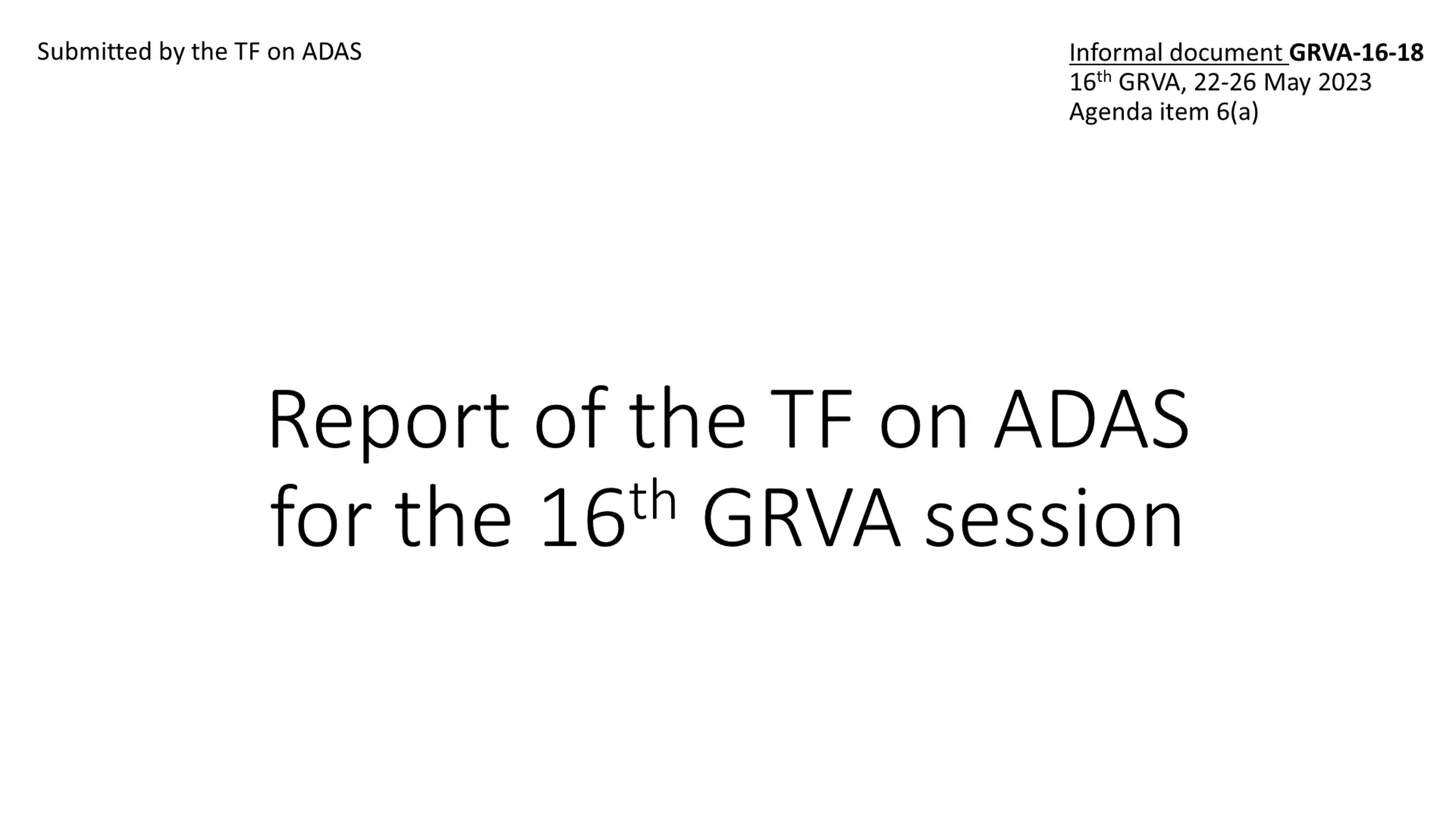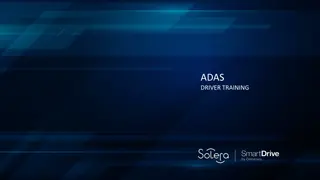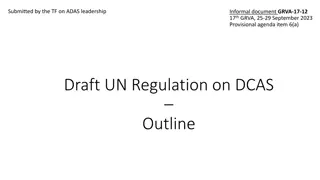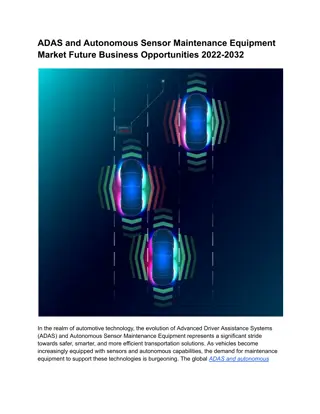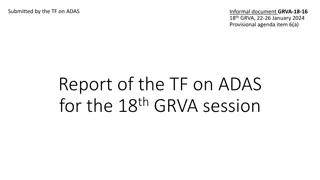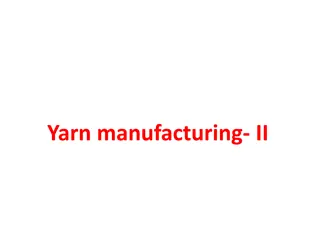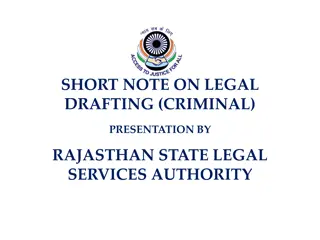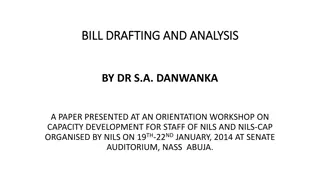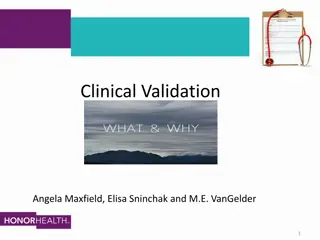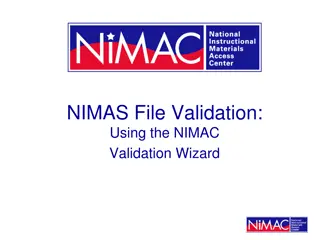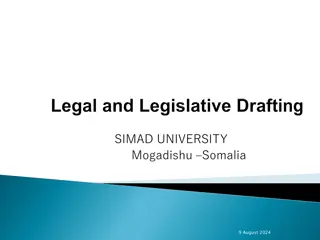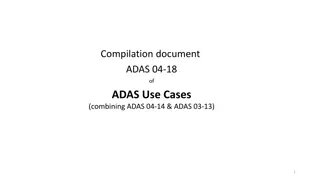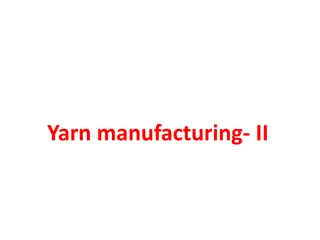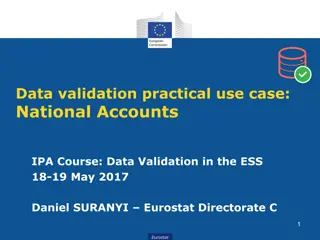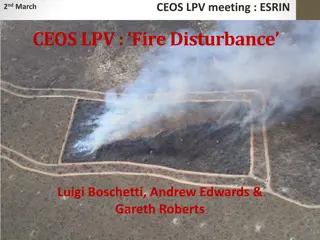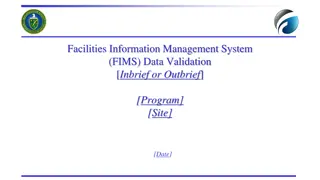Advancing ADAS Regulations: Drafting Progress & Proposed Validation Approach
Steps taken for UN Regulation drafting, split into two phases for submission in Sept 2023 and 2024 respectively. Introduction of a proposed multi-pillar validation approach for DCAS. Progress discussed by the ADAS Task Force.
Download Presentation

Please find below an Image/Link to download the presentation.
The content on the website is provided AS IS for your information and personal use only. It may not be sold, licensed, or shared on other websites without obtaining consent from the author.If you encounter any issues during the download, it is possible that the publisher has removed the file from their server.
You are allowed to download the files provided on this website for personal or commercial use, subject to the condition that they are used lawfully. All files are the property of their respective owners.
The content on the website is provided AS IS for your information and personal use only. It may not be sold, licensed, or shared on other websites without obtaining consent from the author.
E N D
Presentation Transcript
Submitted by the TF on ADAS Informal document GRVA-16-18 16thGRVA, 22-26 May 2023 Agenda item 6(a) Report of the TF on ADAS for the 16thGRVA session
Status after the 15thGRVA session Three online meetings (22 February 2023, 13 April 2023, 15 May 2023) Six online meetings of the Smaller Drafting Group Deeper involvement of the EC-JRC in the drafting process Making concrete progress with the draft DCAS UN Regulation Continued vacant position of the ADAS TF Co-Chair Needed to ensure continuity of activities Link to the TF documents: https://wiki.unece.org/display/trans/ADAS 2
Progress with drafting the DCAS UN Regulation The Small Drafting Group (SDG) was set up at the 11thADAS TF session The SDG participants: RUS, EC-JRC, NL, UK, AVERE, OICA, CLEPA, AAPC, ETSC The SDG: Continues the development of the Master Document Addressed separating DCAS between UN R 79 and DCAS UN Regulation Targeted to submit the working document for the 17thGRVA session in September 2023 The latest Master Document ADAS-20-02 was discussed at the ADAS TF on 15 May Per the EC proposal and agreement by TF ADAS, the work activity has been prioritized into two phases to facilitate the objective of submitting the DCAS regulation for GRVA s consideration this year: The first phase aims to regulate advanced driver-initiated and system-initiated features, not regulated currently by ECE R 79. An amendment of ECE R79 removing ACSF D and E categories may be required. The second phase would address so-called hands-off features. The targeted submission of the proposal at the 20thGRVA session in September 2024. The relevant amendments to the ADAS Task Force Deliverables and Timings (GRVA- 09-15) would be proposed at the next GRVA session 3
Proposed Approach for DCAS Validation (ADAS-17-03) Similar to the NATM, to implement multi-pillar techniques for the assessment of DCAS: The multiple assessment techniques compensate uncertainties related to operational cases that are not assessed directly and thus cover DCAS multiple operational cases that should be assessed; Extensive assessment through multiple pillars allows a deep assessment of the manufacturer s design (e.g., functional safety, controllability, driver engagement strategies) and allows for system flexibility to dynamically handle environments. This in turn avoids requiring the definition of specific limit values. Appropriate behavior and control is verified in test scenarios; In addition, the manufacturer will be required to monitor and report on system performance following entry into service; The enhanced assessment techniques are not new; they are already known and implemented in other areas: this would ensure easier implementation of those in the DCAS UN Regulation; Further work is ongoing to mature the assessment annexes in the coming weeks 4
The Issue of Driver Education Implementation of DCAS requires appropriate understanding by the driver the performance capabilities of DCAS available on the vehicle. TF on ADAS had received a proposal introducing requirements related to ensuring that the driver maintains sufficient knowledge on the appropriate use of DCAS, which the OEM or DCAS would be required to be evidence and/or confirm in order to enable operation of DCAS. However, within a UN Regulation, we cannot establish requirements which apply to drivers. Thus, this could not be resolved in the context of the DCAS regulation regulating a vehicle system. Nevertheless, the DCAS draft Regulation does include requirements on the manufacturer to provide educational materials for consideration by the driver. These requirements do not guarantee driver review. The above proposal touches on the broader topic of driver education and to what respect this should be updated in order to incorporate operation of vehicles equipped with ADAS/DCAS systems. Similarly, drivers or operators may need specific education in order to operate vehicles with ADS or emergency safety systems. As the issue of drivers education is understood to be a responsibility of WP.1, we believe that common recommendations by WP.1 addressing this matter are needed and should be developed. This issue may need to be added to the list of topics of WP.29 and WP.1 common interest. We suggest bringing up this matter to the attention of AC.2 and WP.29. 5
L2 Hands-Off Features: Deeper Discussion Needed A report of the L2 Hands-Off study commissioned by the VDA was presented to the 17thADAS TF session on 19 January 2023 (ADAS-17-05). As a follow-up, Q&A document (ADAS-19-06) was provided by the research organization in response to the questions and comments raised by the ADAS TF stakeholders. The ADAS TF stakeholders suggested to consider alternative study results and invite their authors to give presentations to the ADAS TF. EC/JRC proposed deeper discussion of the L2 Hands-off features and suggested postponing the development of the relevant provisions to the second phase of the DCAS UN Regulation, to be completed in 2024. The ADAS TF leadership considers organizing (a) separate (from the ongoing drafting process) workshop(s) dedicated to L2 Hands-Off Systems. The outcome of the workshop(s) would help to elaborate the regulatory provisions for the Level 2 Hands-off systems. The stakeholders were invited to provide follow-up to the Q&A document ADAS- 19-06 (if any) and the items for the discussion at the workshop. The information about the workshop will be provided to the ADAS TF stakeholders in advance. 6
DCAS Master Document Review Process Updated Stages & Timing 17 GRVA Sep. 23 Draft 3 (final) (for phase 1) 14 GRVA Sep. 22 Draft 1 16 GRVA May 23 20 ADAS TF 15 May 23 Draft 2 = ADAS-20-02 Interim 14 ADAS TF 30 Aug. 22 Draft 1 = ADAS-14-02 We are here Stage 3 Stage 1 Stage 2 Stage 1 overview and restructuring identify issues (redundancies, contradiction with principles, interpretation ) to be solved on the Stage 2 Stage 2 detailed review agree on content of the requirements Stage 3 fine tuning finalize wording and definitions 7
Short-Term Workplan 1 June 2023, 13:00-15:00 CET 20thSDG session online; 13-14 June 2023 21stSDG session in-person in Europe; After that session 21stADAS TF session online; Submitting the working document to the 17thGRVA session by 30 June 2023; Outstanding issues, if any, could have been discussed before the 17th GRVA session with the preparation of an informal document, if needed. Additional ad-hoc meetings will be organized if needed. 8
Back-up 10
Background GRVA adopted at its 9thsession in February 2021 the terms of reference for the Task Force on Advanced Driver Assistance Systems (ADAS). The Task Force (TF) focuses on Advanced Driver Assistance Systems (ADAS), and shall address the simplification of UN Regulation No. 79 and if needed, develop a new ADAS UN Regulation with a focus on ADAS systems up to of level 2 (as defined in ECE/TRANS/WP.29/1140). The TF on ADAS agreed to start developing a new UN Regulation 11
Two Parallel Workstreams of the TF Development of the provisions for the new ADAS use cases Working on the pending proposals for UN R 79 Development of the definitions, classification and scope of regulatory activities Analysis of ADAS use cases and associated requirements Finding open issues hindering to adopt the proposals Development of the high-level regulatory items for ADAS Proposals on how to resolve open issues New UN Regulation on longitudinal + lateral control on a sustained basis Drafting the amended proposals to UN R 79 12
Agreed DCAS Key Principles 1. Driver refers to a human being driving a vehicle. 1.1. A DCAS does not replace the driver (ADS); a DCAS assists the driver (ADAS). 1.2. A DCAS does not change the driver s responsibilities for control of the vehicle. A DCAS is a driver-operated vehicle system. 2.1. A DCAS must prevent reasonably foreseeable risks of driver misuse or abuse. 2.2. A DCAS must have means to evaluate continuous driver involvement in and supervision of the vehicle operation. 2.3. A DCAS do not aim to permit driver activities other than driving in addition to those permitted for manual driving. 2.4. A DCAS must provide sufficient information to enable the driver to supervise its motion-control assistance. A DCAS assists the driver via sustained lateral and longitudinal motion-control support. 3.1. The DCAS support must not adversely impact road safety. 3.2. The DCAS support must not adversely impact driver control over the vehicle behavior. The availability of a DCAS to the driver is constrained by defined system boundaries. 4.1. The manufacturer must describe the system boundaries. 2. 3. 4. 13
Proposed Multi-Pillar Techniques for the DCAS Validation Audit of the manufacturer s documentation Track tests DCAS compliance assessment Type Approval Physical tests Road tests COP assessment COP inspection Post Type Approval In-service monitoring and reporting 14
Details of the Audit of the Manufacturers Documentation Audit of the manufacturer s documentation Description of DCAS functions and control strategies DCAS layout and schematics Safety of intended functionality (per e.g., ISO 21448) Assurance of DCAS controllability At normal operation Safety concept of the manufacturer Functional safety (per e.g., ISO 26262) At fault conditions Relevance to the specific provisions of DCAS UN Regulation Generation of scenarios for the assessment of DCAS Results of virtual testing (voluntary) Results of simulation Results of physical tests performed by the manufacturer Virtual model credibility assessment Manufacturer s safety management system 15
